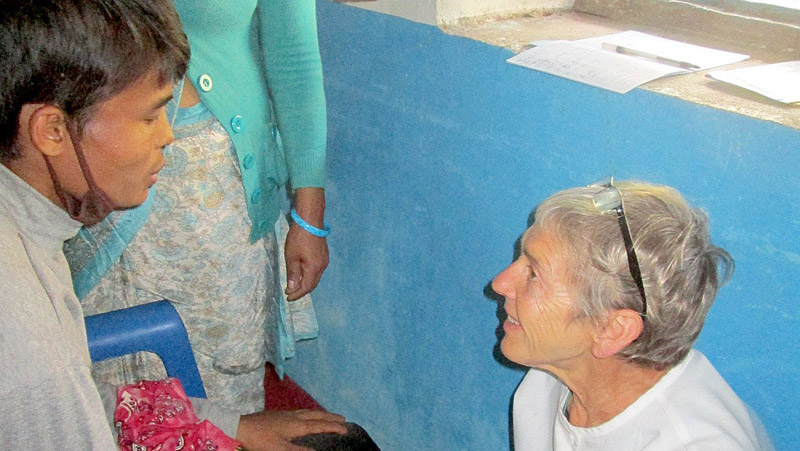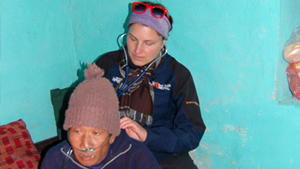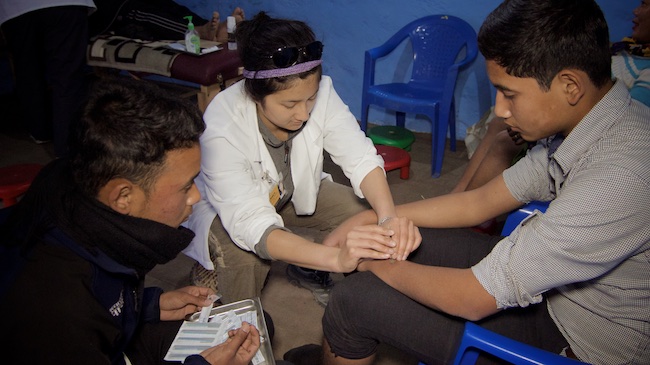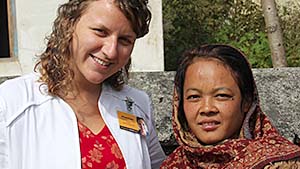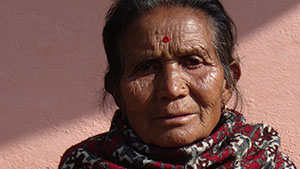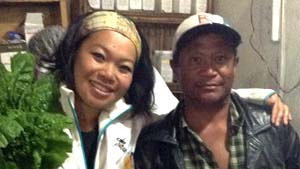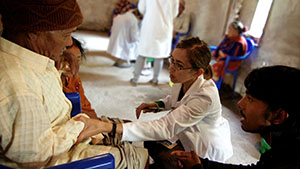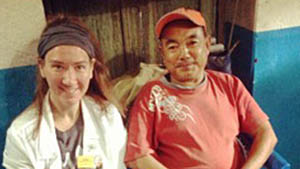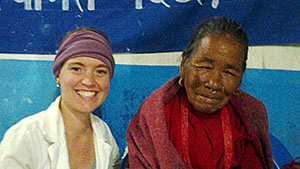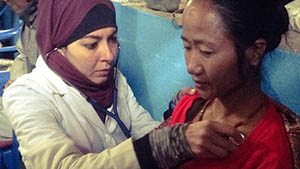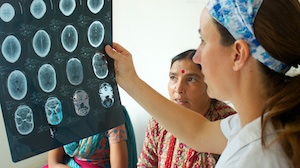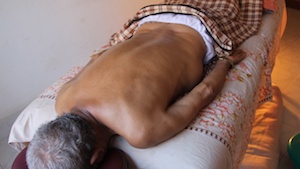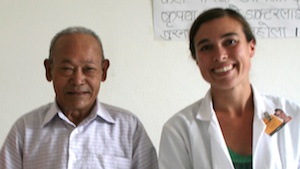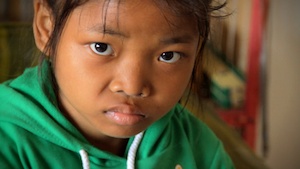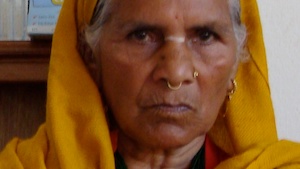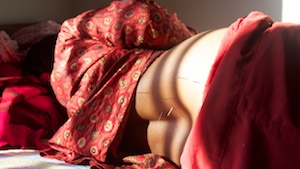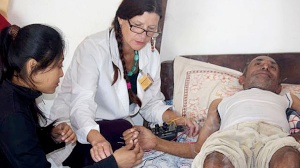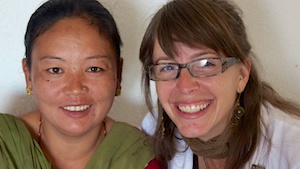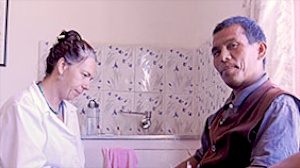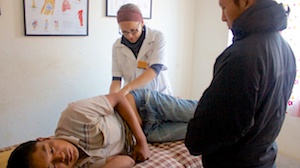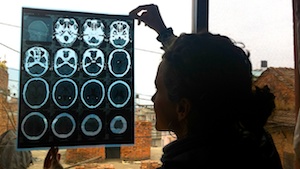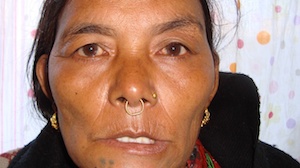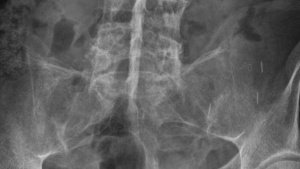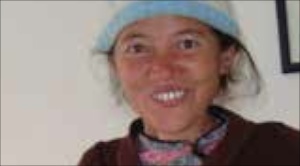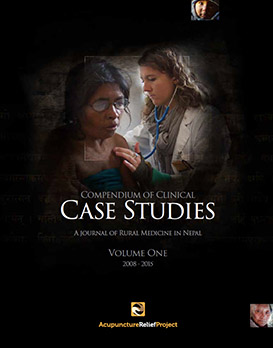Beth Fitzgerald DPT
November 2014
OVERVIEW
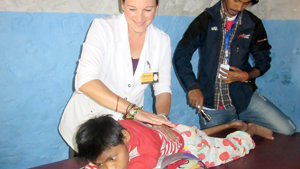
Severely malnourished and non-ambulatory 11-year-old female presents with increased tone and spasticity in all extremities, frequent seizures, and currently requiring assist for all mobility. Patient was seen for a total of 10 physical therapy treatments with significant improvement in passive range-of-motion, moderate improvement in posture and spasticity, slight improvement in active range-of-movement, and a 50% decrease in seizures.
Subjective
11-year-old female patient is carried into clinic with significant tightness in all extremities. Per caregiver report, she has minimal social interaction, an inability to feed or dress herself, toilet or ambulate, and currently requires assist for all activities of daily living and all mobility. Caregiver reports a seemingly normal development until the age of 2 when “all of her muscles got tighter” and began to alter her mobility. She was able to crawl, ambulate and communicate. However, between the ages of 2 and 5, she had a pronounced increase in muscle tone, paralysis, and began having difficulty with all mobility. At 5 years old, she started using a cane to ambulate and progressively stopped walking and speaking. A vague history, slowly gathered over the course of multiple treatments, includes a difficult birth, which required forceps, 21 days in a paralysis ward around 6 years old with no reported improvement, and a subsequent lack of social interaction. On the 6th visit, it was revealed that she was neglected by her parents and confined to her bed for extended periods of time. The current caregiver is a distant relative as the parents do not want to care for her unless she is able to feed and toilet herself. The caregiver’s goal is for the patient to move better and walk more.
Objective
On the initial visit, the patient appears to be very agitated, and his eyes dart around the room as he walks through. His mother holds his arm to physically lead him in and direct him around the clinic. After he is seated, he continuously turns around to look out the window so his chair is turned to allow him to focus on the activity outside, which calms him slightly. Due to his mother’s concern about touching him too much, pulses are palpated lightly. They are fast and full. He is warm to the touch. He is partially uncooperative with tongue diagnosis, but he does open his mouth and curls his tongue upwards. Sublingual veins are engorged and purple. He is agitated, and swats at anyone who is standing too close. At times, the interpreter stands outside the window to distract him and keep him visually occupied.
His mother accompanies him on each visit to answer questions, and to provide assistance with bus travel. They travel 1.5 hours each way to get to the clinic, so regular treatments are somewhat of a challenge.
He is frail in appearance. Blood pressure is not taken as he does not want the compression on the arm. His mother points to his chest, makes motions with her hand and tries to describe the appearance of the chest. The shirt is not removed, however from the description it is possible he may have pectus ecavatum, which is the most common congenital deformity of the anterior chest wall. Several ribs and the sternum grow abnormally, producing a caved-in or sunken appearance of the chest, which is consistent with how she is describing him. Gentle palpation of the chest and sternum do not confirm a deformity.
Assessment
DX: Spastic quadriplegic cerebral palsy
Spastic quadriplegia is defined by spasticity of the limbs, rather than strict paralysis. It is distinguishable from other forms of cerebral palsy in that those afflicted with the condition display stiff, jerky movements stemming from hypertonia of the muscles. The primary effects of cerebral palsy are impairment of muscle tone, gross and fine motor functions, balance, control, coordination, reflexes and posture. Swallowing and feeding difficulties, speech impairment, and poor facial muscle tone can also indicate cerebral palsy. Associative conditions, such as sensory impairment, seizures and learning disabilities can also occur. When present, these associative conditions may assist with a clinical diagnosis of cerebral palsy.
DDX: Diagnosis is complicated by lack of past medical history, parents not currently being involved in care to clarify development, and by exacerbation of symptoms secondary to lack of care and stunted growth. Differential diagnoses consist of muscular dystrophy, acquired brain injury and Rett syndrome.
Muscular dystrophy is a group of diseases that weaken the musculoskeletal system. Although more common in males, it can occur in females and is characterized by progressive muscle weakness and wasting, poor balance, atrophy, scoliosis, frequent falls, joint contractures, inability to ambulate and wasting of the muscular system. Patient’s history and initial disease presentation per caregiver report has many of these characteristics. However, muscular dystrophy does not typically involve spasticity. This diagnosis is further ruled out as details of the birth are learned.
Rett syndrome is characterized by a period of normal motor development followed by developmental stagnation and then regression of motor and language abilities. Onset typically occurs between 6 and 18 months of age with subtle developmental delays, developmental progress and then stagnation, followed by developmental regression. Hand wringing is a classic symptom and is often confused with autism. Rett’s can also be confused with cerebral palsy. Regression is actually rarely seen with cerebral palsy and spasticity is uncommon with Rett’s. Initial history gathered exposes a period of normal development followed by regression. This diagnosis is considered due to the reports of regression around 2 years of age. It becomes clear, however, that the regression seen with this patient is most likely due to neglect. Rett Syndrome is further ruled out secondary to spasticity.
Acquired brain injury (ABI) is brain damage caused by events after birth such as stroke, brain tumor, infection, hypoxia or ischemia, and can result in an upper motor neuron lesion possibly resulting in spasticity. Without a detailed and accurate history, it is not possible to rule out an ABI. The patient’s caregiver reports a difficult birth, which is likely the cause of the initial injury. However, with the history of abuse, it is possible that the symptoms were exacerbated by events after birth.
Initial Treatment
The movement patterns of proprioceptive neuromuscular facilitation (PNF) to bilateral UE’s and LE’s are utilized to decrease tone and spasticity. The goal is to facilitate more functional movement patterns, thereby increasing the patient’s ability to participate in activities of daily living, such as self-feeding, mobility and toileting, thus decreasing the caregiver burden. The patterns of movement associated with PNF are composed of multi-joint, multi-planar, diagonal and rotational movements of the extremities with the emphasis on decreasing spasticity and increasing range-of-motion. Movements are initiated passively, progressed to active-assisted, and eventually active if patient is able to assist in a controlled movement. Passive range-of-motion (PROM) to right wrist and hand is performed to prevent further contracture development. All exercises are performed bilaterally and slowly, with a constant smooth motion for 5 minutes to each extremity, allowing the muscles to relax and to decrease tone. Seated and standing balance training is performed with emphasis on trunk control, posture, alignment and weight shifting to the right LE. Weight bearing can be very effective at decreasing tone. Progress is made towards prone over a bolster and quadruped (weight bearing through elbows and knees) to facilitate different body positions, in addition to weight bearing though UE’s, primarily the elbows. Weight bearing exercises are also used to increase bone density, improve circulation, increase strength, promote Lung health and reduce tone and spasticity. Neurological reeducation exercises, such as PNF, are performed to decrease spasticity and facilitate motor control to enhance patient’s ability to move independently and increase functional mobility. Patient is being seen 2-3 times per week to decrease spasticity, promote increased range-of-motion, decrease risk for further contractures, increase mobility, and for continued family training and education. She is also receiving acupuncture after each physical therapy session. Reassessment is to be completed after 6 visits, and appropriate family training and education is initiated. Initial treatment is selected based on severity of presentation, knowledge of limited resources, and family’s education level.
Outcome
Patient was treated 10 times and had significant improvement in passive range-of-motion, moderate improvement in posture and spasticity, slight improvement in active range-of-movement, and a 50% decrease in seizures. Patient had a moderate reduction in spasticity during each session, significant increase in passive ROM, and slight improvement in active ROM (most noted in UE’s) between treatments. She experienced an overall improved affect and social interaction throughout the course of the treatments. She was able to reach out towards people with her left UE, and often able to touch someone’s nose with verbal cues. She could sit with a narrower base of support for up to 30 minutes with supervision only, and stand with contact guard assist (previously requiring physical assist). Additionally, she had some use of her left UE for balance. Patient tolerated prone over bolster with weight bearing and engagement of UE’s for 15 minutes for facilitation of back extensors and head control, also allowing gentle percussion to the back to support respiratory health, and decrease risk of current cough progressing to pneumonia. Family was encouraged to vary patient’s position frequently to increase strength, mobility, Lung health, and opportunity to interact with different environments.
Nutritionally, the patient was encouraged to increase fluids throughout the day and include softer, higher caloric foods for overall increased intake. Extensive caregiver education about cerebral palsy was initiated to increase understanding of the disease and how to best work with, and help, the patient for both patient and caregiver benefit as well as long-term prognosis. The caregiver was highly encouraged to seek acupuncture treatments herself due to the heavy caregiver burden. Training was completed with the caregiver to continue PNF and standing exercises to maintain newly-gained range-of-motion, facilitate weight bearing, reduce spasticity and minimize pain.
This case was complicated simply by the complexity of the diagnosis and high level of care required. Information gathered on the sixth visit revealed significant neglect, further reinforcing the focus of treatments to be caregiver education, a simple home exercise program, and to initiate a search for possible support groups. A referral was made to Cerebral Palsy Nepal, an outreach program offering therapeutic and practical support to 15 of the 75 districts in Nepal. Possible support includes home visits and a mobile team who assist with therapy, acquiring equipment, practical guidance and emotional support to patients and their families. During the initial visit, we discussed methods to increase patient’s food intake, particularly healthy fats, setting up an appointment with a doctor to address possible medications, specifically to manage seizures, a more appropriate and supportive chair for her home to increase interaction with the environment, and perhaps most importantly, supporting and educating the caregiver.
Conclusion
This case was challenging for me at many levels. From the initial evaluation it was apparent that the medical history was extensive, but vague. Though confident with the diagnosis, it took multiple visits to unravel a more complete history. It was important to focus on treating the patient, but also ensure the caregiver could see the benefit so she would continue to bring the patient into the clinic. I tried to provide an environment where she felt supported and open with the patient’s history, as the caregiver was initially guarded and defensive.
Though the patient’s prognosis was poor, I was surprised how much improvement I saw despite the severity and duration of her disease. With minimal prior intervention, I was able to clearly see the effects of my treatment. I was able to make moderate to significant progress with the patient’s active and passive range-of-motion, seated and standing balance, and overall reduction in tone and spasticity. The patient appeared more comfortable, was engaging with the practitioners and actually smiled during the last treatment. Despite this progress, life in rural Nepal is challenging even for a healthy and able-bodied individual, and it is difficult to predict how much carry-over into daily life will occur, as the patient must fully rely on her caregiver.
As the case progressed, it became clearer to me that the most important components were not the actual interventions during treatment, but developing a relationship and providing an environment where the caregiver was open to education, assisting in establishing appropriate connections, and helping to establish relationships for continued support. The burden lies on the caregiver to continue to bring the patient in for treatments, to be open to further education and training, and follow through with a home exercise program.












